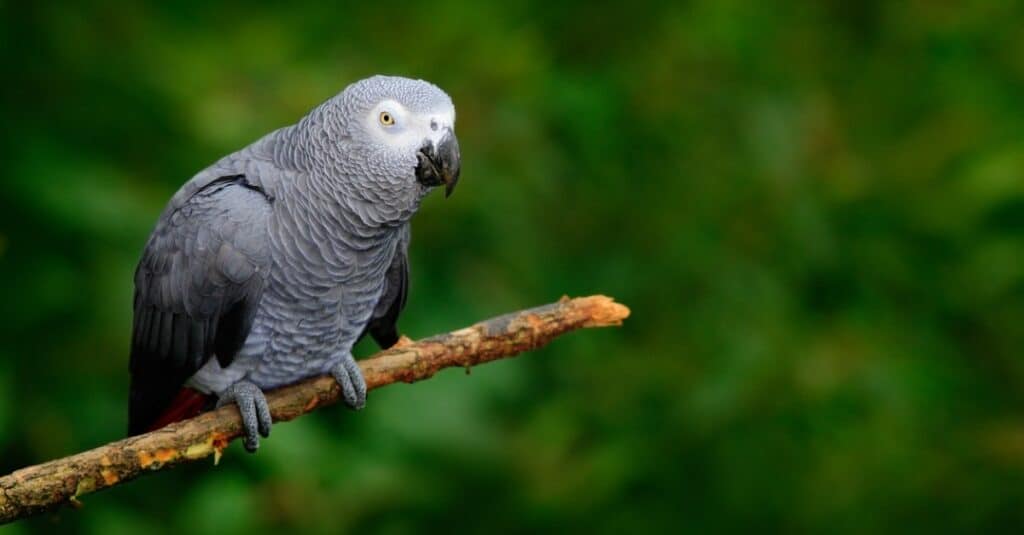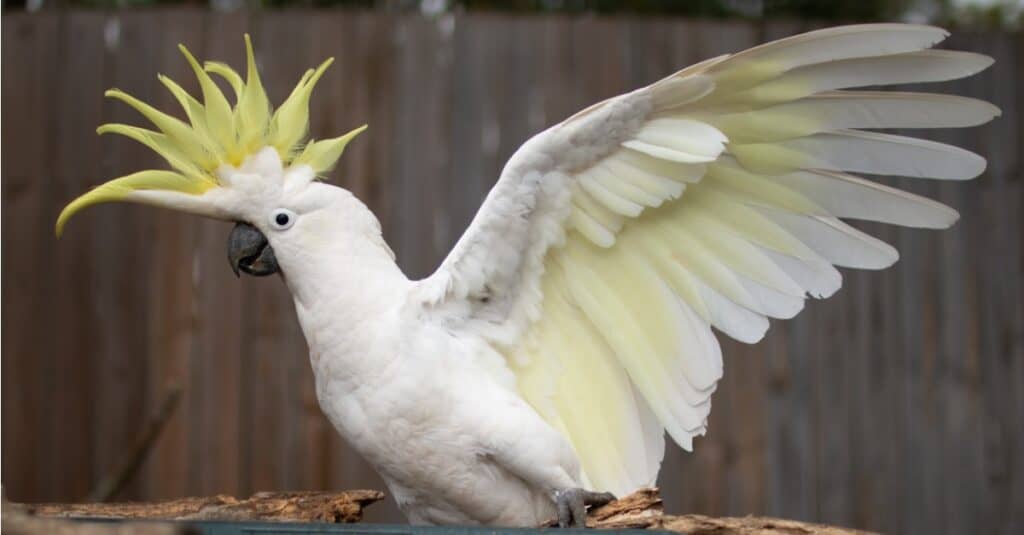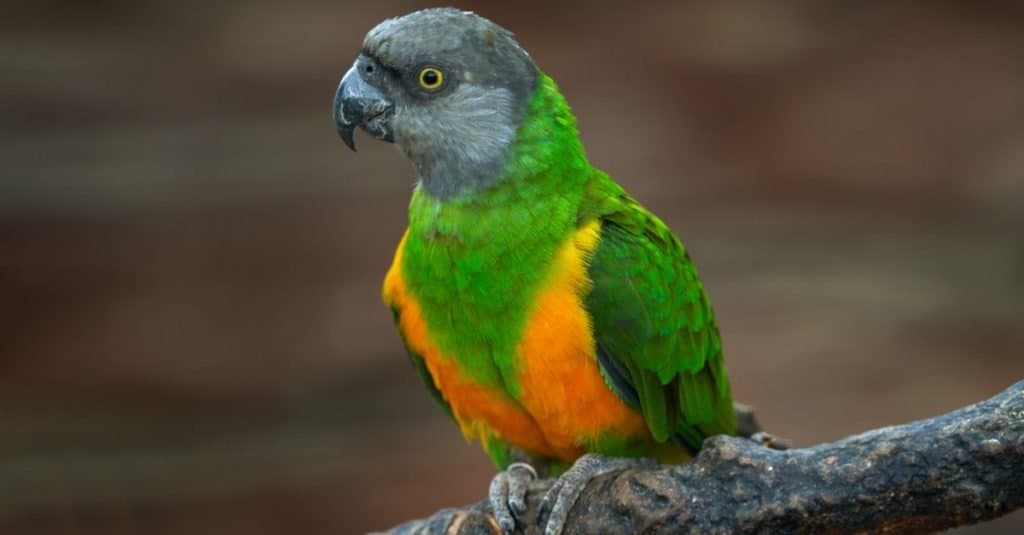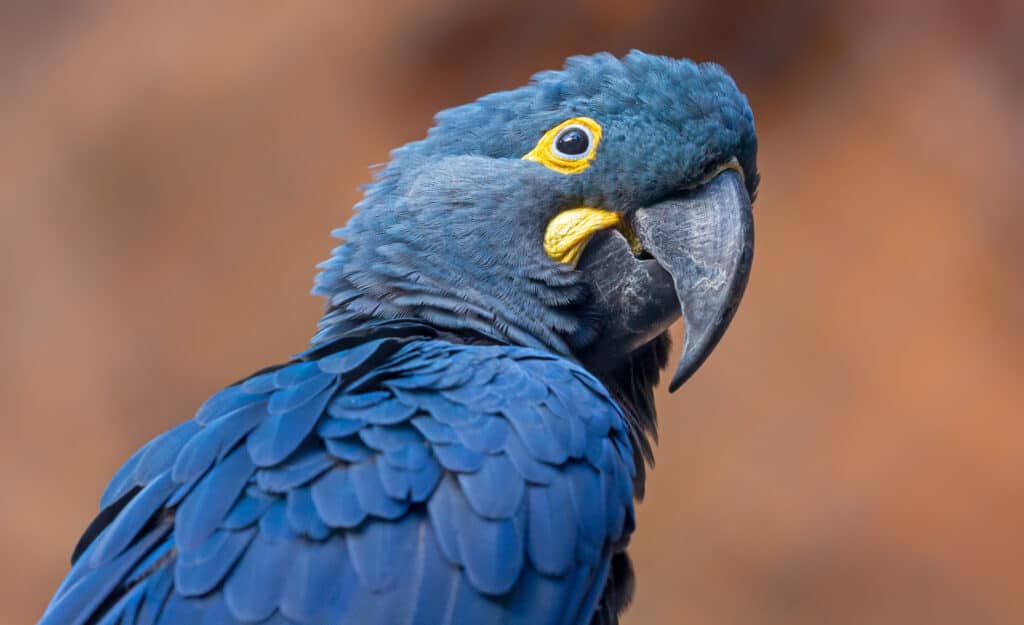If you’re thinking about adding a parrot to your family, this is the article for you. We will discover seven types of Parrot breeds to keep as pets. We’ll take a look at how big they are, how noisy, and how much interaction they need.

©
What Are Parrots?
But first, what are parrots?
There are over 350 species in the parrot family, most of which are brightly colored, intelligent birds. They live in warm habitats like tropical islands and rainforests.
Parrots are zygodactyls, meaning they have four toes on each foot. Two toes reach forward and two backward. This creates their incredible grip and ability to cling on in the most awkward spots. Parrots also have curved beaks and are adept at using them to hold and manipulate objects. They use their beaks to climb, pick things up, and nibble. Their beaks constantly grow, so one of the most important aspects of parrot care is ensuring they have lots to wear their beak growth down.
Let’s jump in and take a look at seven types of parrot breeds to keep as pets.
1. Cockatiel

Cockatiels are easy to care for and great for beginners.
©iStock.com/nicepixel
Cockatiels are very popular in the U.S. and an excellent parrot choice, especially if you are just starting out, because they are easy to care for.
They are simple to identify with their yellow head crests, orange ‘cheddar’ cheeks, and plumage array of white, yellow, gray, and orange feathers. Adult cockatiel sizes range between 9 and 12 inches long, and they can live up to 25 years in captivity.
These cute little birds are the smallest members of the cockatoo family and, like cockatoos, express emotions through their head crest. Upright is happy, and flat is sad or scared. They don’t talk or mimic human words much but trill, whistle, and imitate short tunes. Cockatiels rarely screech or make much noise, so they are one of the quieter pet parrot species.
Although they are native to Australia, where they live in tree cavities, they are a popular type of parrot breed and are kept as pets across the world.
2. African Grey

The African grey Parrot is known as one of the best-talking birds in the world.
©iStock.com/Ondrej Prosicky
African Greys are one of the longest-lived pet parrots, often reaching 60 years old, so it’s possible they may outlive you. Before taking on an African Grey, ensuring someone could ‘inherit’ them is a good idea.
These parrots are the largest parrot type in their native western and central Africa. They inhabit tree hollows and search for seeds, berries, and nuts in lowland moist forests. African Greys are grey, as you might suspect, but they have numerous grey shades right through to bright white, so they are quite beautiful.
They reach around 14 inches long with 20-inch wingspans and have large curved grey beaks that are easily able to manipulate objects. In the wild, they enlarge their nesting cavities with their functional beaks.
Their incredible talking ability is why they are such high-demand pets. Not only do they sing and trill, but they repeat words and learn complex sentences. This has led to high demand; many are poached from the wild. African Greys are endangered due to illegal poaching, so always purchase from a reputable breeder.
African Grey owners say their parrot friends are sociable, happy birds that need lots of interaction to keep them entertained and emotionally well. They make great pets if you are able to give them lots of time. This means they aren’t suitable parrots for people who work out of the home all day long.
3. Cockatoo

The voice of a cockatoo is considered to be loud and harsh.
©QuickStartProjects/Shutterstock.com
Beautiful, bright white cockatoos are the parrots you’ll spot on YouTube headbanging to various tunes! They are well known for their musical love and dancefloor moves, but do they make good pets?
Cockatoos are demanding, long-lived birds that need plenty of interaction and time spent talking and playing. They quickly get depressed without sociable activities and resort to pulling out their feathers. Their tall, bright yellow crest is an emotional barometer. If it’s upright, they are happy, but flat indicates something is making them unhappy.
Owners say these 12-to-30-inch-long, intelligent birds are incredibly noisy because they like to chat, trill, and screech all day long. Sometimes, this is in response to stimulation, but sometimes, they just like to entertain themselves.
One of their funniest habits is throwing a massive tantrum if they don’t get their way, but because they are friendly, playful, and loving, they are excellent, if somewhat high-maintenance, parrot pets on par with dogs in terms of care levels required. They’re best for experienced parrot owners.
4. Senegal Parrot

Senegal parrots are native to West
Africa
and have the most beautiful yellow and green bodies topped with cheeky gray heads.
©Ondrej Prosicky/Shutterstock.com
These parrots are less well-known than cockatoos and African Greys, but they are an excellent type of parrot breed to keep as pets because they are so much calmer and quieter than their cousins. This doesn’t mean they can be ignored, though! Senegal parrots need social activity, toys, love, and care from their owners.
These pretty little parrots are native to West Africa and have the most beautiful yellow and green bodies topped with cheeky gray heads.
As well as their calmer nature, Senegal parrots only reach around nine inches long, so they’re a better choice for small homes than large cockatoos. Despite their quieter, smaller size, they are active birds that love toys and company.
Owners say they are best for immediately experienced owners because they can be a little ‘nippy’ if they don’t get what they want straight away, but because they are loving birds that will happily sit on your shoulder or lap for hours, they are quickly forgiven.
5. Parakeet

Parrot enthusiasts recommended parakeets as one of the best species to keep as a pet because they are small, easy to care for, and don’t require masses of space.
©iStock.com/emranashraf
Parakeets are small and popular birds in the U.S. (they are called budgerigars elsewhere) and, along with cockatiels, make excellent first-time parrots for newbie owners.
The most common are small parrots, measuring up to seven inches long, with vivid yellow and green plumage with black tiger stripes. In the wild, they live in large colonies, and in captivity, they are incredibly social, so it’s best to keep at least two in one cage, especially if you are out for a portion of the day.
Parakeets are curious little birds that like to investigate their owner’s glasses and jewelry and flit around the house looking for new things.
In terms of noise, they are fairly quiet, although some do “speak.” They also trill, chitter, and chirp quietly all day long, so they make a top-notch company, especially for people who are lonely or isolated in some way.
If you’re a first-time bird owner, parrot enthusiasts recommend parakeets as one of the best species to keep as a pet because they are small, easy to care for, and don’t require masses of space. If kept in pairs, they don’t need the almost constant interaction cockatoos and African Grey require.
6. Macaws

Macaws are intelligent birds that like to bond with just their owner.
©iStock.com/tane-mahuta
Everyone loves macaw parrots. They are large 50-inch-long birds with scarlet, blue, yellow, gold, and green plumage. They’re best for experienced parrot owners because they need a lot of interaction, care, and socialization.
They can live for 50 years and need lots of room to stretch their wings and fly about. On top of this, they are very noisy whenever they please and quite capable of waking the whole family (and neighbors) by screeching at night. This isn’t a problem in their native Americas’ rainforest environment, but it is in urban areas.
Macaws are intelligent birds that like to bond with just their owner. They’ll happily spend all day on your shoulder (or your laptop) once they’re comfortable with you. Clever macaws are capable of vocal mimicry, so teaching them to “speak” is an enjoyable part of the bonding process.
7. Love Birds

Without the company of a flock member (or human carer), they get depressed and resort to feather plucking.
©Huy Thoai/Shutterstock.com
Love birds are small, stocky parrots from sub-Saharan Africa and Madagascar. They require lots of love and affection, so they are best kept in pairs. Without the company of a flock member (or human carer), they get depressed and resort to feather plucking.
A love bird reaches up to seven inches long, so they are small birds perfect for apartments. In terms of care required, they are needier and a little feistier than cockatiels and parakeets but are still funny, affectionate pets and a great choice for newbie parrot keepers.
Summary of 7 Types of Parrot Breeds to Keep as Pets
Here is a summary of the 7 types of Parrot breeds to keep as pets. Most of these birds, if not all, need to have a companion bird so they won’t get lonely.
| # | Parrot Breed | Experience Level |
|---|---|---|
| 1 | Cockatiel | Beginner |
| 2 | African Grey | Intermediate |
| 3 | Cockatoo | Experienced |
| 4 | Senegal Parrot | Intermediate |
| 5 | Parakeet | Beginner |
| 6 | Macaws | Experienced |
| 7 | Love birds | Beginner |
The photo featured at the top of this post is © Vaclav Matous/Shutterstock.com
Thank you for reading! Have some feedback for us? Contact the AZ Animals editorial team.






